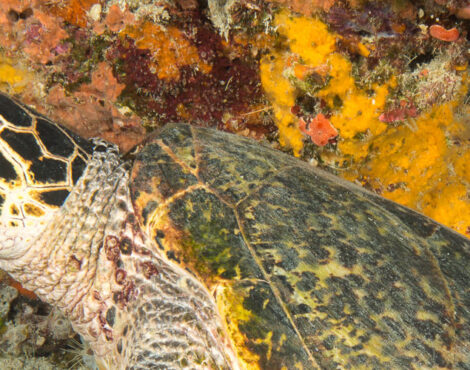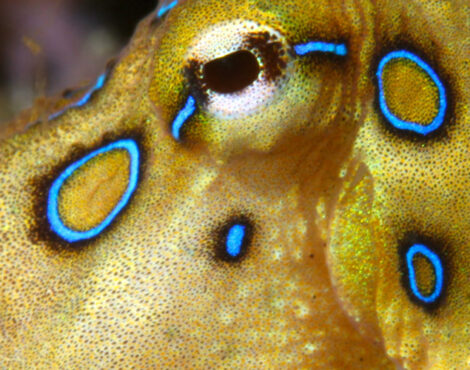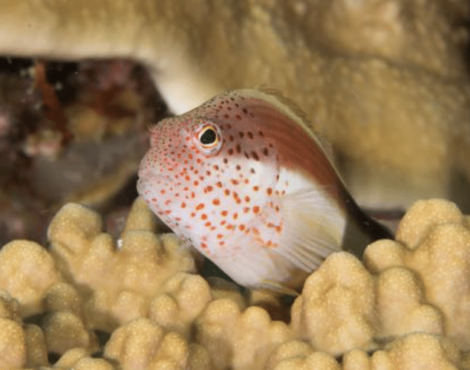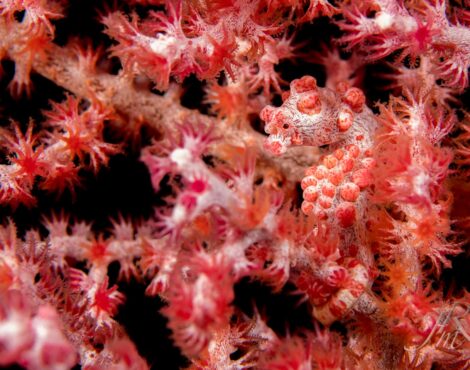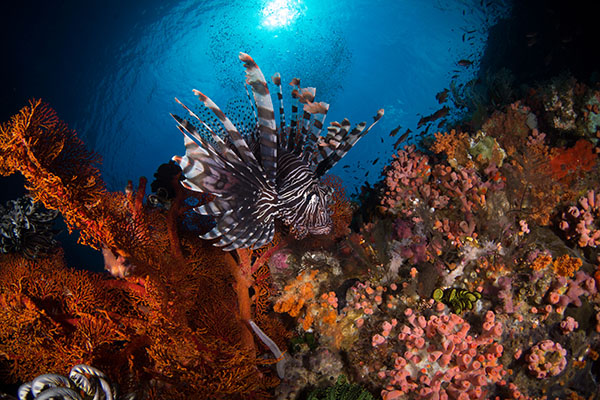
The waters surrounding Bunaken Marine Park are among the most diverse on Earth. The park boasts more than an estimated 2,000 species of reef fish, with more constantly being discovered.
One of the more photogenic fish genus we regularly encounter is Pterois â or more commonly known as Lionfish. They are frequently spotted lurking around the deep walls surrounding Buanken and the sandy muck slopes of North Sulawesi. Despite being relatively common, they are always a firm favourite among our guests, and because of their flamboyancy, beauty, and lack of fear, they are one of the most photographed fish in the region.
What are Lionfish?
Lionfish is the common name for fish in the genus Pterois, also commonly known as zebrafish, turkeyfish, or firefish. There are 12 recognised species of lionfish, four of which can be easily spotted around Bunaken Marine Park â the Common Lionfish, Red Lionfish, Twinspot Lionfish, and the Andover Lionfish.
They are a member or the family Scorpaeniformes, which means they are closely related to scorpionfish, and as such, all lionfish are venomous. All lionfish have around 18 venomous spines â typically two pelvic, three anal, and thirteen dorsal.
What does a Lionfish Look Like?
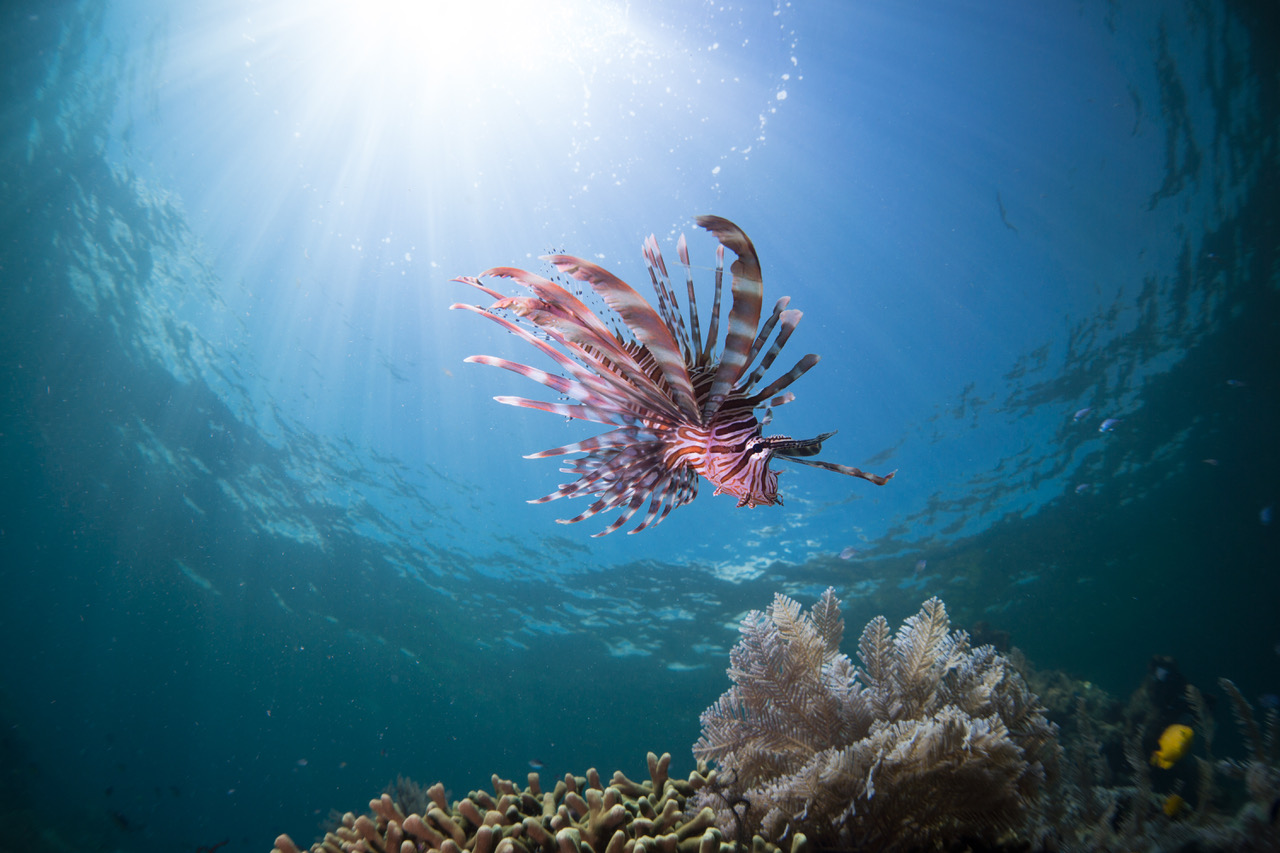
Unlike scorpionfish, lionfish are not camouflaged, instead opting for highly conspicuous markings to alert any potential predators of their toxicity. Although their colouration varies from species to species, for the most part they have a pale red/tan body with dark brown zebra like stripes.
They have long feathery pectoral fins which are used to both attract smaller fish for prey, and to warn off any potential predators. Their size varies dramaticly between species, with the smallest growing to no more than five centimetres, and the largest growing over 30 centimetres.
What do Lionfish Eat?
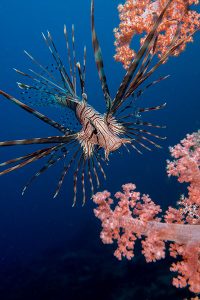 Like their scorpionfish cousins, Lionfish are carnivorous, meaning they survive entirely on animal material. They are opportunistic hunters, which means they are not particularity picky about what they eat.
Like their scorpionfish cousins, Lionfish are carnivorous, meaning they survive entirely on animal material. They are opportunistic hunters, which means they are not particularity picky about what they eat.
Their primary food source is molluscs and invertebrates, however they will also use their long pectoral fins to attract small fish in the same way a frogfish would use its lure. Once the fish is within range, it will use their quick reflexes and swallow their prey whole.
They are considered voracious predators as they can consume large amounts of prey in a short space of time â they can eat up to thirty times their own stomach volume, which is extremely problematic in some parts of the world. When food is scarce, lionfish will happily devour other smaller lionfish â which makes them cannibalistic.
Are Lionfish Invasive?
We have had a number of guests commenting on the amount of Lionfish around Bunaken Marine Park â and we have even had people ask if we do anything to control the population. This is because in the Caribbean, they are highly invasive and because of the quantity of food they can eat in one go, they are devastating juvenile fish populations.
Lionfish are native to the Indo-Pacific, so we have no need to worry about the number of lionfish in the region. In the Caribbean, they have no real predators of their own, so their numbers have been rapidly growing and they have spread very fast throughout the region â threatening the fragile coral reef ecosystems they have invaded.
In their native waters, lionfish have a number of natural predators to keep their population in check. Their natural predators include snapper, grouper, sharks, and even Bobbit worms have been observed eating them.
How do Lionfish Reproduce?
Lionfish are typically solitary fish, and they only really come together when it is time to mate. Similar courtship behaviour is seen in all lionfish species â including circling one another, leading/following, and sidewinding. When they come together to mate, there will be several females and usually only one male.
As they are nocturnal, this behaviour typically happens around nightfall and continues throughout the night. After courting, the female will release two egg masses which will be fertilized by the male. Once fertilized, the eggs will float towards the surface before drifting away with the current. The embryos have an adhesive mucus which allow them to attach to corals and intertidal rock pools. A single female can lay up to 30,000 eggs during the mating season, however most of these will never hatch.
Where can I Dive with Lionfish?
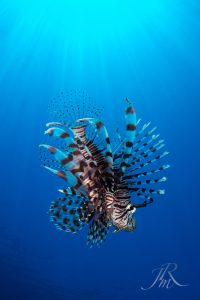 Lionfish can be found at any dive site throughout Bunaken Marine Park, and although they are nocturnal, you can easily find them during the day when they are hiding in sponges and under table corals.
Lionfish can be found at any dive site throughout Bunaken Marine Park, and although they are nocturnal, you can easily find them during the day when they are hiding in sponges and under table corals.
The common and the red lionfish are the most common species found during the day and on the walls, where as the twin spot and Andover are only really spotted during night dives. There is not really any dive site in particular that is good or bad for finding lionfish, however you are likely to find many while night diving on the mucky slopes of the North Sulawesi coastline.
The lionfish around Bunaken have learnt that night divers will bring light with them, which helps the lionfish hunt. It is quite common to turn around during a night dive and have three or four lionfish following you, waiting for you to illuminate a fish so it can pounce. Because of this, you should be especially aware of what is happening with your legs so you donât brush into one by accident. It is also a good idea to cover your legs with a full body wetsuit so if this does happen, the chances of getting stung are low.


